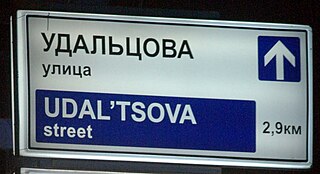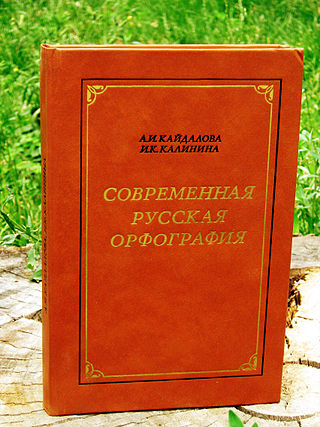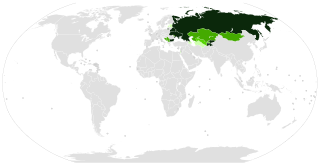Bibliography
- Paul Garde, La Transcription des noms propres français en russe, Paris, Institut d'études slaves, 1974, 63 pages, 25 cm, collection « Documents pédagogiques de l'Institut d'études slaves » n° X, ISBN 2-7204-0090-4
Russian uses phonetic transcription for the Cyrillization of its many loanwords from French. Some use is made of Cyrillic's iotation features to represent French's front rounded vowels and etymologically-softened consonants.
In the table below, the symbol ⟨ʲ⟩ represents either a "softened" consonant or the approximant /j/. When applicable, a softened consonant can be indicated in transcription either by a following iotated vowel or by ⟨ ь ⟩.
| French | Russian transcription | Examples | Comments | |
|---|---|---|---|---|
| phoneme(s) | grapheme(s) | |||
| [b] | b | б | bateau-lavoir – бато-лавуар | |
| [ʃ] | ch | ш | Charles – Шарль | |
| [d] | d | д | Bordeaux – Бордо | |
| [f] | f, ph | ф | Foucault – Фуко | |
| [ɡ] | g, gu | г | Guillaume – Гийом | |
| [ɲ] | gn | нь | Boulogne – Булонь | |
| – | h | – | Humanité – Юманите | |
| г | Hugo – Гюго Le Havre – Гавр | often in the case of h aspiré | ||
| [ʒ] | j, g(e) | ж | Jean – Жан | |
| [k] | c, qu, k | к | Camus – Камю | |
| [l] | l | ль | Gilbert – Жильбер | before a consonant or at the end of a word |
| л | Louvre – Лувр | before vowels | ||
| [lj] | li | ль | Montpellier – Монпелье | |
| [m] | m | м | monde – монд | |
| [n] | n | н | Rhône – Рона | |
| [ŋ] | ng | нг | ||
| [p] | p | п | Pierre – Пьер | |
| [ʁ] | r | р | Renoir – Ренуар | |
| [s] | s, ç, c | с | Rousseau – Руссо | |
| [sj] | ti | сь | Libération – Либерасьон | |
| [t] | t | т | pointe – пуэнт | |
| [v] | v | в | Verlaine – Верлен | |
| [w] | w | в | Gwénaël – Гвенаэль | sometimes transliterated with ⟨ у ⟩ in loanwords from English |
| [ks] [kz] | x | кс кз | Xavier – Ксавье Saint-Exupéry – Сент-Экзюпери | according to the pronunciation of the ⟨x⟩ |
| [j] | y, i, il(l) | й | yeuse – йёз Bayard – Байяр Guillaume – Гийом | after a vowel or word-initially |
| ь | Lavoisier – Лавуазье | after a consonant | ||
| il(l) | ль | Marseille – Марсель | frozen form | |
| [z] | z, s | з | Vierzon – Вьерзон | |
Doubled French consonants remain doubled in their Russian transcription: Rousseau – Руссо. Silent consonants (common in French) are generally not transcribed, except where they exist in the surface form due to liaison .
| French | Russian transcription | Examples | Comments | |
|---|---|---|---|---|
| phoneme(s) | grapheme(s) | |||
| [a], [ɑ] | a, â | а | Charles – Шарль | |
| [e], [ɛ] | é, è, ê, ai, e | е | René – Рене | |
| э | Edmond – Эдмон Citroën – Ситроэн | at the beginning of a word, following a vowel, or rarely for [ɛ] at the end of a word | ||
| [ø], [œ] | eu, œ, œu | ё | Villedieu – Вильдьё | ⟨ ё ⟩ is generally simplified to ⟨е⟩ in Russian |
| э | Eugène – Эжен Maheu – Маэ | at the beginning of a word, or after a vowel | ||
| [ə], — | e | – | Charles – Шарль | e muet |
| е | De Gaulle – Де Голль | only in cases where [ə] is usually pronounced, e.g., le , de , que , rebelle , etc. | ||
| [i] | i, y | и | Village – Виляж | |
| [o], [ɔ] | o, au, ô | o | Rhône – Рона | |
| [wa] | oi | уа | Troyes – Труа | |
| [u], [w] | ou | у | Louvre – Лувр | |
| [y], [ ɥ ] | u | ю | L'Humanité – Юманите | |
| [ɑ̃] | an, am, en, em | ан, ам | Ambroise – Амбруаз Occidental – Оксиданталь | nasal vowels are written as the corresponding oral vowel followed by /n/ (or /m/ before /m, b, p/) |
| [ɛ̃] | in, en, ain | ен, ем, эн, эм | Saintes – Сент Ain – Эн | |
| [ɔ̃] | on, om | он, ом | Comte – Конт | |
| [œ̃] | un | ен, ем, эн, эм | Verdun – Верден | |
| [wɛ̃] | oin | уэн | pointe – пуэнт | |
Finally, the softened consonants modify the following vowels:
| hard Russian vowel | softening | Examples | Comments | |
|---|---|---|---|---|
| After a vowel or ⟨й⟩ | After a consonant or ⟨ь⟩ | |||
| ʲа | я | cognac – коньяк Bayard – Байяр | ||
| ʲе ; ʲё | ие, йе ; йё | ье ; ьё | trieur – триер Cahiers du cinéma – Кайе дю синема Richelieu – Ришелье | |
| э | ⟨э⟩ never follows a softened consonant | |||
| ʲи | йи | ьи | Tilly – Тийи | |
| ʲо | йо | ьо | Chillon – Шильон | |
| ʲу | ю | |||
| ʲю | йю | ью | ||
| ʲ | before a consonant or at the end of a word, softening is written with ⟨ь⟩ | |||
Neither ⟨й⟩ nor ⟨ь⟩ are doubled.

The International Phonetic Alphabet (IPA) is an alphabetic system of phonetic notation based primarily on the Latin script. It was devised by the International Phonetic Association in the late 19th century as a standardized representation of speech sounds in written form. The IPA is used by lexicographers, foreign language students and teachers, linguists, speech–language pathologists, singers, actors, constructed language creators, and translators.

The Russian alphabet is the script used to write the Russian language. It comes from the Cyrillic script, which was devised in the 9th century for the first Slavic literary language, Old Slavonic. Initially an old variant of the Bulgarian alphabet, it became used in the Kievan Rusʹ since the 10th century to write what would become the modern Russian language.

A digraph or digram is a pair of characters used in the orthography of a language to write either a single phoneme, or a sequence of phonemes that does not correspond to the normal values of the two characters combined.
When used as a diacritic mark, the term dot is usually reserved for the interpunct, or to the glyphs "combining dot above" ( ◌̇ ) and "combining dot below" ( ◌̣ ) which may be combined with some letters of the extended Latin alphabets in use in Central European languages and Vietnamese.
A yer is either of two letters in Cyrillic alphabets, ъ and ь. The Glagolitic alphabet used, as respective counterparts, the letters (Ⱏ) and (Ⱐ). They originally represented phonemically the "ultra-short" vowels in Slavic languages, including Old Church Slavonic, and are collectively known as the yers.

The Bulgarian Cyrillic alphabet is used to write the Bulgarian language. The Cyrillic alphabet was originally developed in the First Bulgarian Empire during the 9th – 10th century AD at the Preslav Literary School.

The romanization of the Russian language, aside from its primary use for including Russian names and words in text written in a Latin alphabet, is also essential for computer users to input Russian text who either do not have a keyboard or word processor set up for inputting Cyrillic, or else are not capable of typing rapidly using a native Russian keyboard layout (JCUKEN). In the latter case, they would type using a system of transliteration fitted for their keyboard layout, such as for English QWERTY keyboards, and then use an automated tool to convert the text into Cyrillic.

Russian orthography is formally considered to encompass spelling and punctuation. Russian spelling, which is mostly phonemic in practice, is a mix of morphological and phonetic principles, with a few etymological or historic forms, and occasional grammatical differentiation. The punctuation, originally based on Byzantine Greek, was in the seventeenth and eighteenth centuries reformulated on the French and German models.

The soft sign is a letter in the Cyrillic script that is used in various Slavic languages. In Old Church Slavonic, it represented a short or reduced front vowel. However, over time, the specific vowel sound it denoted was largely eliminated and merged with other vowel sounds.

Yeru or Eru, usually called Y[ɨ] in modern Russian or Yery or Ery historically and in modern Church Slavonic, is a letter in the Cyrillic script. It represents the close central unrounded vowel after non-palatalised (hard) consonants in the Belarusian and Russian alphabets, and after any consonant in most of Rusyn standards, where it represents the unrounded close-mid back unrounded vowel sound.

The Ukrainian alphabet is the set of letters used to write Ukrainian, which is the official language of Ukraine. It is one of several national variations of the Cyrillic script. It comes from the Cyrillic script, which was devised in the 9th century for the first Slavic literary language, called Old Slavonic. In the 10th century, it became used in Kievan Rus' to write Old East Slavic, from which the Belarusian, Russian, Rusyn, and Ukrainian alphabets later evolved. The modern Ukrainian alphabet has 33 letters in total: 20 consonants, 2 semivowels, 10 vowels and 1 palatalization sign. Sometimes the apostrophe (') is also included, which has a phonetic meaning and is a mandatory sign in writing, but is not considered as a letter and is not included in the alphabet.
In Slavic languages, iotation is a form of palatalization that occurs when a consonant comes into contact with the palatal approximant from the succeeding phoneme. The is represented by iota (ι) in the early Cyrillic alphabet and the Greek alphabet on which it is based. For example, ni in English onion has the sound of iotated n. Iotation is a phenomenon distinct from Slavic first palatalization in which only the front vowels are involved, but the final result is similar.
In English orthography, many words feature a silent ⟨e⟩, most commonly at the end of a word or morpheme. Typically it represents a vowel sound that was formerly pronounced, but became silent in late Middle English or Early Modern English.

The letter Ъ of the Cyrillic script is known as er golyam in the Bulgarian alphabet, as the hard sign in the modern Russian and Rusyn alphabets, as the debelo jer in pre-reform Serbian orthography, and as ayirish belgisi in the Uzbek Cyrillic alphabet. The letter is called back yer or back jer and yor or jor in the pre-reform Russian orthography, in Old East Slavic, and in Old Church Slavonic.
This article deals with the phonology of the standard Ukrainian language.
In Russian, the term spelling rule is used to describe a number of rules relating to the spelling of words in the language that would appear in most cases to deviate from a strictly phonetic transcription.

Numerous Cyrillic alphabets are based on the Cyrillic script. The early Cyrillic alphabet was developed in the 9th century AD and replaced the earlier Glagolitic script developed by the Byzantine theologians Cyril and Methodius. It is the basis of alphabets used in various languages, past and present, Slavic origin, and non-Slavic languages influenced by Russian. As of 2011, around 252 million people in Eurasia use it as the official alphabet for their national languages. About half of them are in Russia. Cyrillic is one of the most-used writing systems in the world. The creator is Saint Clement of Ohrid from the Preslav literary school in the First Bulgarian Empire.
The Cyrillic script family contains many specially treated two-letter combinations, or digraphs, but few of these are used in Slavic languages. In a few alphabets, trigraphs and even the occasional tetragraph or pentagraph are used.

Yo, Jo or Io is a letter of the Cyrillic script. In Unicode, the letter ⟨Ё⟩ is named CYRILLIC CAPITAL/SMALL LETTER IO.

Proto-Slavic is the unattested, reconstructed proto-language of all Slavic languages. It represents Slavic speech approximately from the 2nd millennium BC through the 6th century AD. As with most other proto-languages, no attested writings have been found; scholars have reconstructed the language by applying the comparative method to all the attested Slavic languages and by taking into account other Indo-European languages.